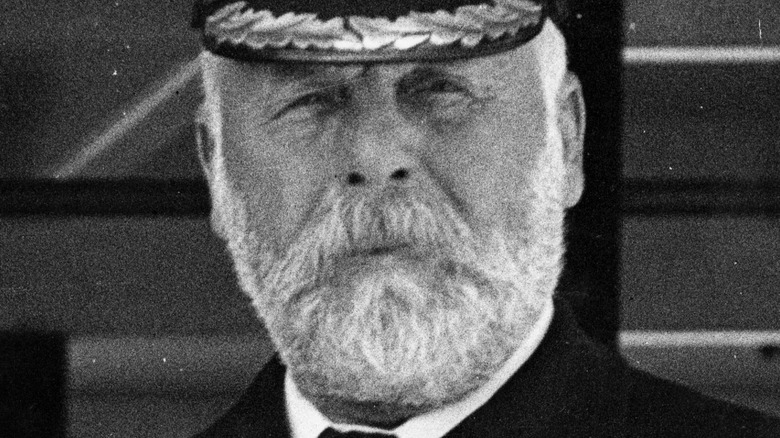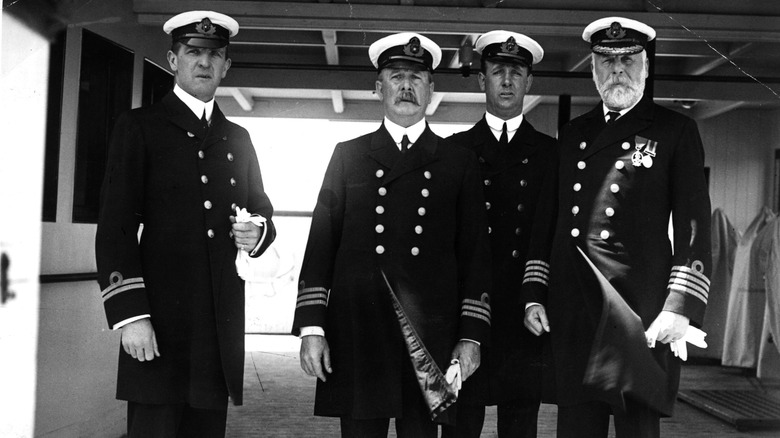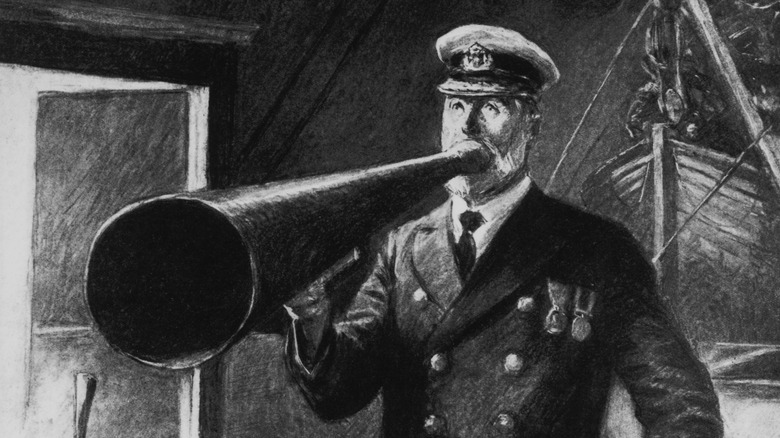These Were The Haunting Last Words Of The Titanic's Captain
When Titanic struck an iceberg just after 11:30 p.m. on April 14, 1912, the impact felt like little more than a slight jarring to those aboard. A few passengers even picked up chunks of ice that had fallen on the deck and dropped them in their drinks to cool them. It didn't seem like that big of a deal. But below deck, it was another story. The luxury passenger liner, the jewel of the British White Star line, helmed by Captain Edward John Smith, was on its maiden voyage from Southampton, England, to New York City when the partially submerged mountain of ice tore into the ship's hull about 400 miles south of Newfoundland, Canada.
Thomas Andrews, Titanic's head designer, went below to assess the damage, and what he saw floored him. He ran to tell Capt. Smith. Seawater was pouring into the boiler room near the ship's bow as well as in the room next door because the iceberg punched through six watertight compartments. Capt. Smith immediately understood what this meant: Titanic was doomed. Andrews believed they had only 60 to 90 minutes before Titanic would sink, so Smith began evacuating his ship. The crew members rounded up the women and children first, corralled them into the lifeboats, and prioritized first-class passengers. The captain, meanwhile, ordered the crew to send out distress signals and fire rockets. He still held out hope of rescue even as the lifeboats below hit the icy water.
Who was Captain Edward Smith?
Captain Edward Smith, born on Jan. 27, 1850, was a seasoned sailor who began his naval career while still a teenager. He had been with the White Star line for nearly 40 years. His crew respected him, and he was beloved by passengers, especially the ones in first class, earning the title the "Millionaire's Captain" (per Britannica). While the Titanic disaster was by far his worst accident at sea, it wasn't his first. On more than one occasion, his ships ran aground. And just six months prior to Titanic, on Sept. 20, 1911, the White Star passenger liner Olympic, with Smith as captain, collided with the Royal Navy cruiser Hawke near the Isle of White in the English Channel, causing extensive damage to both ships.
The Royal Navy blamed Olympic and the ensuing legal defense by the White Star line, as well as repairs to the ship, were financially hard on the company. White Star backed their captain, who would contend that his record at sea was unblemished. "When anyone asks me how I can best describe my experience in nearly forty years at sea, I merely say, uneventful. In all my experience, I've never been in any accident, or any sort worth speaking about," Smith said, according to Titanic: History's Most Famous Ship. As the clock ticked into the early morning hours of April 15, 1912, Capt. Smith must have realized that his tenure as a ship's captain, and most likely his life, was coming to a close. He called his crew members together.
Captain Edward Smith dismissed his crew
While Titanic continued to sink, the wireless operators stayed at their station, desperately trying to send out distress messages over their radio transmitters in any hope of rescue. Just after 2 a.m., Captain Smith came in and relieved them of their duties, so they could attempt to save themselves. Below deck, the engineers stayed at their posts attempting to pump the water out, which helped ensure the power stayed on as long as possible. Even the ship's musicians stayed at their post, playing music to calm the wildly panicked passengers.
With no help left, Capt. Smith spoke to his crew. "Well boys, you've done your duty and done it well. I ask no more of you. I release you," he told them, according to The Mirror. "You know the rule of the sea. It's every man for himself now, and God bless you." What happened next remains clouded in myth and mystery. Various sources allege a rush of water swept Smith overboard, that he died by suicide, or that he jumped from the deck with a child in his arms that he placed in one of the lifeboats. The version most historians agree on is that told by an eyewitness, Harold Bride, the surviving wireless operator, who said Smith dove "from the bridge into the sea," per History. Smith, along with nearly 700 of the ship's crew members, died. Of the 2,200 people on board, only 700 survived, mostly women and children.
If you or anyone you know is having suicidal thoughts, please call the National Suicide Prevention Lifeline by dialing 988 or by calling 1-800-273-TALK (8255).


